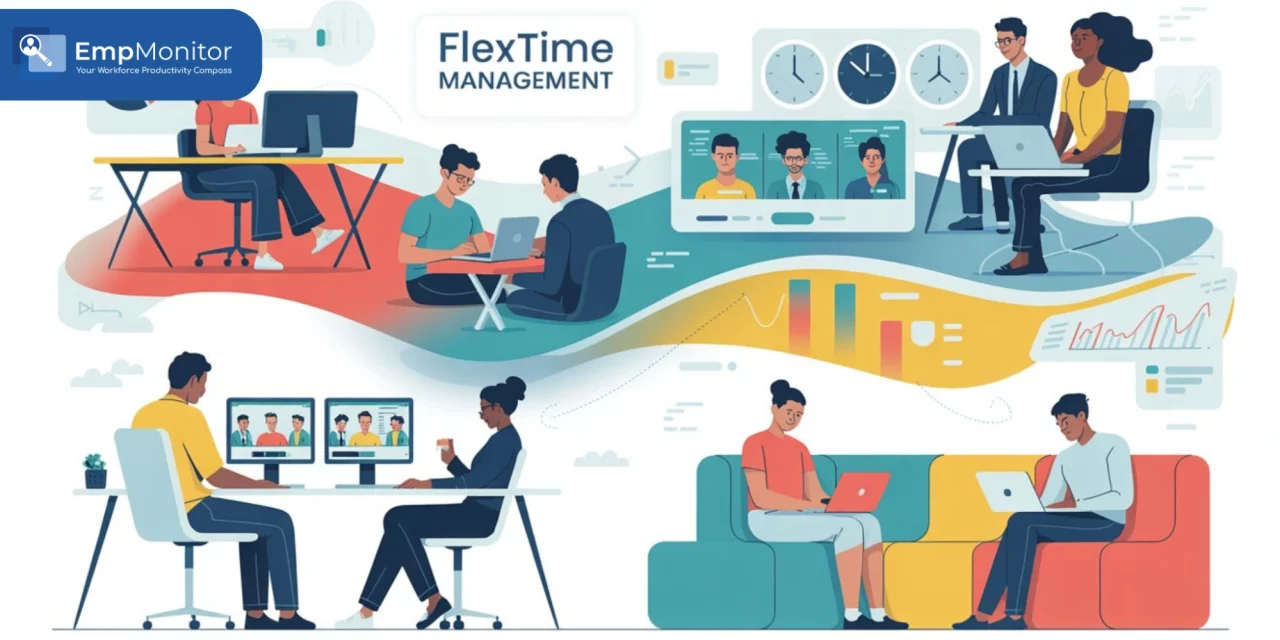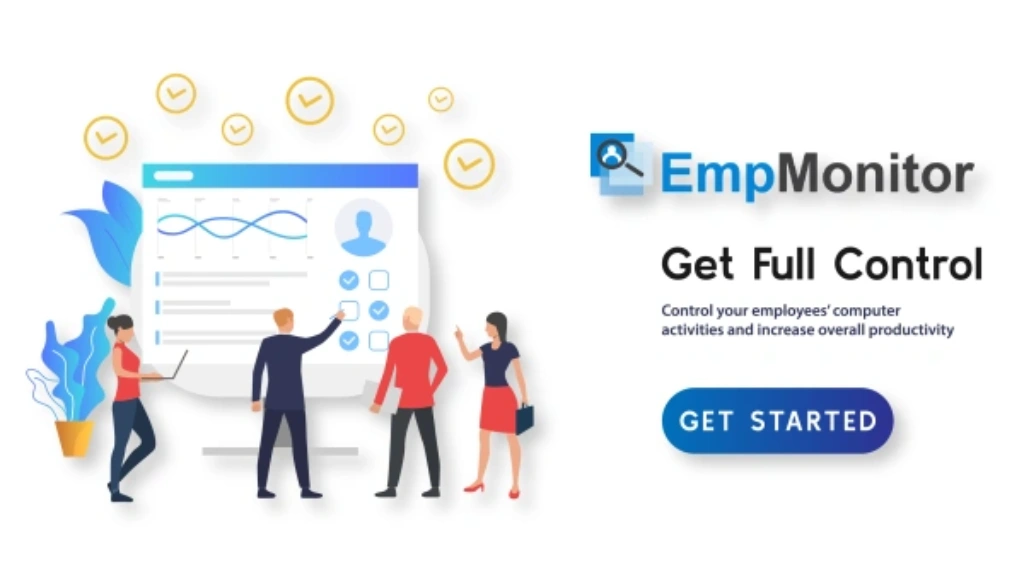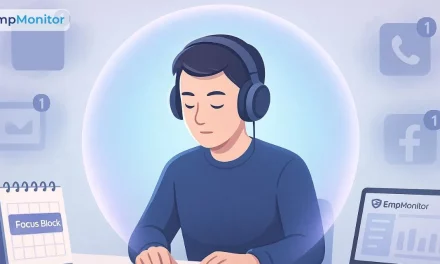Have you ever wondered what a flextime manager does?
The answer to this question is simple. A flextime manager ensures that the team stays productive, connected, and on track, even with flexible schedules.
Flexible work hours are becoming the standard, but with flexibility comes the challenges: coordinating projects, maintaining clear communication, and ensuring deadlines are met can become tricky. Therefore, having the right strategies is important.
In this guide, we walk you through 10 proven tips every flextime manager should know, providing practical advice you can start using today to help your team succeed, no matter when or where they work.
In a hurry? Listen to the blog instead!
What Is Flextime Manager?
The flextime manager ensures that the work will be done on time, deadlines will be met, and every team member stays connected, even if people are starting and finishing at different times.
A flextime manager does not simply schedule changes. They set expectations, check in with team members, solve problems, and help everyone stay productive.
The key thing you need to remember is that being a flextime manager is about balancing freedom and structure. You want your team to enjoy flexibility, but you also need to ensure that projects move forward and communication does not break down.
Challenges Of Flextime Manager
Managing a team with flexible hours sounds great until you actually start doing it. However, it is not always as simple as it appears. Flextime gives people freedom, but this freedom comes with a few tricky challenges.
Communication gaps
When everyone works at different times, it is easy to miss updates or decisions. Messages can get lost, and small issues can turn into bigger ones simply because people are not online at the same time.
Tracking performance
It is difficult to know who is doing what when you cannot see everyone working. Traditional ways of measuring productivity do not always fit flexible schedules; therefore, new ways to track progress fairly must be found.
Maintaining team connection
When people are not in sync, it is harder to build team spirit. A good flextime manager must find ways to keep everyone engaged and ensure that no one feels left out.
Avoiding burnout
Flexible hours can sometimes blur the lines between work and personal life. Some people might end up working longer because it is easy to stay connected. It is key to help your team set healthy boundaries.
Once you are aware of these challenges, you can manage them. The next section covers practical tips to help you handle flexibility.
Let’s dive in.
10 Tips for Effective Flextime Management
Managing a team with flexible schedules comes with its own set of challenges, but it also offers an opportunity to boost productivity and morale. These 10 tips will help you navigate flextime management effectively, keeping your team connected, accountable, and motivated.
Tip 1: Set Clear Core Hours for Team Collaboration
One of the smartest things a flextime manager can do is set core hours, fixed hours each day when everyone is available. These hours become your team’s overlapping time for meetings, updates, and quick catch-ups.
For example, everyone could be available between 11 AM and 3 PM. Outside of that, people can choose when to start or finish their workdays. This simple rule keeps everyone connected without compromising their flexibility.
Core hours help prevent miscommunication, one of the biggest problems in flexible work. When everyone knows that there is a time when they can reach others, things move quickly, and confusion decreases.
The idea is not to control when people work. This ensures that your team still feels like a team, even when their schedules do not match perfectly.
Tip 2: Communicate Expectations Early and Often
When your team works on flexible schedules, communication is not something you can leave to chance. As a flextime manager, you need to be clear about what you expect and repeat it often.
Start by setting the basics: Working hours, deadlines, meeting times, and how people should update their progress. It helps to write these things down somewhere everyone can see, such as a shared document or your team’s chat channel.
In addition, do not assume that one message is sufficient. In a flexible setup, people log in and out at different times, so reminders are the best option. A quick check-in or short weekly summary can go a long way in keeping everyone aligned.
The goal is not to micromanage. This is to ensure that no one feels out of the loop. When communication is clear and frequent, your team can focus on work instead of guessing what is expected.
Tip 3: Use Smart Tools to Manage Flextime Teams
A good flextime manager depends on technology to keep things running smoothly in the workplace. Tools like EmpMonitor and its time-tracking software help everyone see who is working when and what is due.
The EmpMonitor’s Project management system makes it easy to assign tasks, track progress, and spot bottlenecks, even if your team is scattered across different hours or locations.
With the right tools in place, you can spend less time chasing tasks and more time supporting your team and helping them to succeed.
Tip 4: Track Performance Based on Results, Not Hours
One of the biggest mistakes a flextime manager can make is to focus too much on when people are working instead of what they are accomplishing. Flexible schedules are not about clocking hours; they are about getting results.
Set clear goals and outcomes for your team, and measure success based on those results. For example, instead of checking if someone is online from 9 to 5, look at whether they are meeting deadlines, hitting targets, or delivering quality work.
This approach also builds trust among stakeholders. Your team feels empowered to manage their own time, and you can focus on helping them succeed, rather than micromanaging.
Remember: productivity is not about sitting at a desk; it is about getting work done efficiently and effectively. Track output, celebrate achievements, and adjust if something is not working.
Tip 5: Build a Culture of Trust and Accountability
Flexible schedules only work when your team trusts each other and trusts you as a flextime manager. Without trust, people might feel anxious about taking time off or working different hours, and their productivity can suffer.
Start by setting clear expectations and holding everyone accountable, including yourself. If you say core hours are from 11 AM to 3 PM, make sure you are online too. Recognize good work, provide regular feedback, and encourage your team to support each other.
Accountability does not mean micromanaging; it is about ensuring that everyone knows their responsibilities and feels responsible for delivering. When trust and accountability are strong, flexible schedules feel like freedom rather than chaos.
Tip 6: Support Work–Life Balance for Your Team
One of the best parts about flexible schedules is that they can improve work–life balance, but only if you, as a flextime manager, actively support them. Without guidance, some team members might overwork themselves, while others may struggle to stay focused.
Encourage your team to set boundaries with their work. They suggested defining a clear start and end time, taking breaks, and disconnecting after work. Lead by example, if you are constantly sending messages late at night, your team will feel pressured to do the same.
Regularly check in to see how everyone is handling their workload. Ask for feedback, listen, and adjust schedules if needed. When your team feels balanced, they will be happier, more productive, and more loyal.
Tip 7: Provide Ongoing Training for Flextime Managers
Being a flextime manager is not something that can be mastered overnight. The world of flexible schedules is constantly changing, and ongoing training can make a significant difference.
Training can cover effective communication across different hours, remote leadership skills, efficient use of scheduling tools, and management of productivity without micromanagement. Even short workshops or online courses can help you handle challenges more confidently.
The more you learn, the better you can support your team members. Moreover, staying updated shows your team that you are invested in making flexible work actually work for everyone.
Read More
Flexitime- Adapting To The New Arrangement Of Working
The Complete Guide To Flexible Work Schedules
Tip 8: Create Fair and Transparent Scheduling Policies
One key to successful management of flextime is fairness. If your team feels that some people receive preferential treatment, it can quickly lead to frustration and tension. Therefore, flextime managers require clear and transparent scheduling policies.
Ensure that everyone knows the rules: how shifts are assigned, how time-off requests are handled, and how schedules are adjusted during busy periods. Post these policies somewhere easily accessible and review them regularly.
Being upfront and consistent does not just prevent misunderstandings; it builds trust. When everyone understands how decisions are made, flexible work feels fair, and the team can focus on getting results instead of worrying about schedules.
Tip 9: Gather Feedback and Adjust Regularly
Even the best plan can hit bumps, which is why a good flextime manager keeps checking in with their team. Feedback is your guide to what is working and what is not.
Ask your team how the schedule feels, if core hours are helpful, or if they are facing any challenges. Surveys, quick check-ins, or one-on-one conversations can be used. Then, do not just listen—act on the feedback. Schedules should be adjusted, policies tweaked, and new tools tried if needed.
Regular feedback ensures that your flexible schedule supports productivity and well-being. It also shows your team that their opinions matter, which builds engagement and trust in the organization.
Tip 10: Lead by Example in Your Flextime Strategy
As a flextime manager, your team watches what you do more than what you say. If you want them to embrace flexible schedules, you need to practice what you preach.
Following the same core hours, respecting your own work–life boundaries, and communicating clearly are essential. Show your team that flexibility does not mean slacking; it means managing time responsibly while getting work done.
Leading by example sets the tone for the entire team to follow. When your actions match your expectations, everyone feels more confident and motivated to succeed in a flexible schedule..
Why Flextime Managers Need EmpMonitor?
EmpMonitor is a software that helps flextime managers track their team’s productivity and performance. It runs in the background without disrupting the work and operates on Windows, Mac, and Linux.
With EmpMonitor, you can see how your team spends their time, monitor attendance, and efficiently manage flexible schedules. It provides clear visibility, helping you stay on track while supporting a flexible work environment.
Key Features of EmpMonitor
EmpMonitor comes with a bunch of features that make a manager’s life easier.
- Activity Monitoring: See what is happening on your team’s computers in real time, helping you stay informed and address issues quickly.
- Time Tracking & Attendance: Automatically track when team members log in and out and monitor productive hours without manual spreadsheets.
- Productivity Insights: Get reports on app and website usage to understand patterns and identify areas for improvement.
- Task and Project Tracking: Assign tasks, monitor progress, and ensure deadlines are met, even when schedules differ.
- Custom Alerts: Set notifications for specific activities to act quickly if something needs attention.
- Data Security: Protects company information with features such as monitoring USB activity and secure cloud storage.
Conclusion: Mastering Flextime Management
Being a flextime manager comes with challenges, but it also offers a chance to build a happier, more productive team.
Learning how to use Flextime Manager effectively means setting clear expectations, tracking results instead of hours, fostering trust, and using smart tools such as EmpMonitor. With the right approach, flexible schedules can work for everyone.
Remember, flexibility does not imply chaos. With the right strategies, communication, and systems in place, you can keep your team aligned, motivated, and performing at their best, regardless of when they work.
FAQ: Flextime Management & Tools
Q1: Is flextime applicable to all types of teams?
Not every team can use a flexible schedule. Flextime works best for roles where output can be measured by results rather than hours, such as knowledge work, marketing, or IT work. Teams with strict operational hours may require a hybrid approach.
Q2: How often should a flextime manager review their schedules?
It is good practice to review schedules at least quarterly. This ensures that workloads are balanced, deadlines are met, and any changes in team needs or projects are accounted for.
Q3: Is monitoring software such as EmpMonitor invasive?
No. Tools like EmpMonitor run discreetly and focus on tracking productivity, time, and tasks, not personal activities. When used transparently, they build accountability while respecting the privacy of the subjects.
Q4: How do I motivate my team under a flexible schedule
Motivation stems from clear goals, recognition, and support. Flextime managers can encourage autonomy, celebrate achievements, and provide growth opportunities to keep their teams engaged.
Q5: Can flexible work schedules reduce employee turnover?
Yes. Employees who have control over their working hours tend to be more satisfied and loyal to their organizations. Offering flextime can be a strong retention strategy if it is managed well.






















